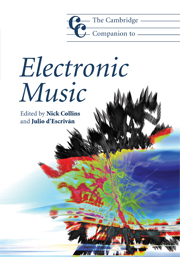Book contents
- Frontmatter
- Introduction
- Part I Electronic music in context
- Part II Electronic music in practice
- 5 Interactivity and live computer music
- 6 Algorithmic composition
- 7 Live audiovisuals
- 8 Network music
- 9 Electronic music and the moving image
- 10 Musical robots and listening machines
- Part III Analysis and synthesis
- Notes
- References
- Index
7 - Live audiovisuals
from Part II - Electronic music in practice
Published online by Cambridge University Press: 28 September 2011
- Frontmatter
- Introduction
- Part I Electronic music in context
- Part II Electronic music in practice
- 5 Interactivity and live computer music
- 6 Algorithmic composition
- 7 Live audiovisuals
- 8 Network music
- 9 Electronic music and the moving image
- 10 Musical robots and listening machines
- Part III Analysis and synthesis
- Notes
- References
- Index
Summary
From festivals and dances, through opera, theatre and shadow play, from Wagner's Gesamtkunstwerk (total artwork), to cinema and virtual reality, the arts have often confronted the problems and potential of engaging many human senses (modalities) at once. Such multi sensory (multimodal) entertainments are often underlined by strongly traditional narratives, yet linear storytelling is not necessarily the primary concern of some alternative artistic ventures. The degree to which any of these media allows for live performance varies, and this chapter will particularly treat the circumstance where the artistic output can be influenced during the course of performance itself, rather than being cast as a fixed product prior to presentation. A parallel chapter on music for broadcast media will analyse the opposing case, where the determination of a finished product, even if subject to a deadline, can be carried out free of realtime concert constraints. Yet there will necessarily be some overlap, and this chapter will in particular treat the case of some formative historical influences on contemporary live performers including the non-realtime work of abstract film visionaries such as Oskar Fischinger. We shall further broach some of the psychological and analytical perspectives on audiovisual work.
To give an immediate example of current concerns, one contemporary manifestation of realtime performance is exhibited by club VJs – video or visual jockeys. Whilst their profile in publicity billing and on-stage position has not matched historically to that of their foils, the club DJ (disc jockey), interest in VJ practice is very much on the ascendant in the arts (Spinrad 2005; Jaeger 2005). Thetypical VJ, if suchan artist can be said to exist,will use dedicated software packages on a laptop computer, often mixed in realtime with prerecorded imagery on DVD and/or live video from a camera. The resulting imagery is centrally displayed by projector(s) in the performance environment. Frequently, analysis of the audio signal, tap tempo, or other control allows the synchronisation of visual events to music. It should be acknowledged, however, that these techniques are by no means universally performed; many VJs control all visuals manually.
- Type
- Chapter
- Information
- The Cambridge Companion to Electronic Music , pp. 126 - 139Publisher: Cambridge University PressPrint publication year: 2007
- 1
- Cited by

